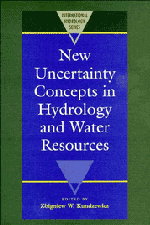Book contents
- Frontmatter
- Contents
- List of Authors
- Preface
- I INTRODUCTION
- II FACETS OF UNCERTAINTY
- 1 Bayesian relative information measure – a tool for analyzing the outputs of general circulation models
- 2 A stochastic weather generator using atmospheric circulation patterns and its use to evaluate climate change effects
- 3 Hydrological uncertainty – floods of Lake Eyre
- 4 Some aspects of hydrological design under non-stationarity
- 5 New plotting position rule for flood records considering historical data and palaeologic information
- III NOVEL APPROACHES TO UNCERTAINTY: FRACTALS, FUZZY SETS AND PATTERN RECOGNITION, NON-PARAMETRIC METHODS
- IV RANDOM FIELDS
- V TIME SERIES AND STOCHASTIC PROCESSES
- VI RISK, RELIABILITY AND RELATED CRITERIA
3 - Hydrological uncertainty – floods of Lake Eyre
Published online by Cambridge University Press: 07 May 2010
- Frontmatter
- Contents
- List of Authors
- Preface
- I INTRODUCTION
- II FACETS OF UNCERTAINTY
- 1 Bayesian relative information measure – a tool for analyzing the outputs of general circulation models
- 2 A stochastic weather generator using atmospheric circulation patterns and its use to evaluate climate change effects
- 3 Hydrological uncertainty – floods of Lake Eyre
- 4 Some aspects of hydrological design under non-stationarity
- 5 New plotting position rule for flood records considering historical data and palaeologic information
- III NOVEL APPROACHES TO UNCERTAINTY: FRACTALS, FUZZY SETS AND PATTERN RECOGNITION, NON-PARAMETRIC METHODS
- IV RANDOM FIELDS
- V TIME SERIES AND STOCHASTIC PROCESSES
- VI RISK, RELIABILITY AND RELATED CRITERIA
Summary
ABSTRACT The uncertainty aspects of the process of floods of Lake Eyre are examined. The available records of floods cover the time span of 40 years only. As longer time series of precipitation records are available, one has extended the observed series of inflows to Lake Eyre with the help of a rainfall–runoff model. Further reconstruction of the inflow series has been achieved with the help of proxy data of coral fluorescence intensity. However the limitations of these extensions and reconstructions of inflows are severe. The process of inflows to Lake Eyre could be considered one of the most convincing manifestations of hydrological uncertainty.
LAKE EYRE AND ITS BASIN
Lake Eyre, a large depression in arid Australia, rarely filled with water, attracts the interest of limnologists, hydrologists, geomorphologists and ecologists all over the world. The process of inflows to Lake Eyre has been recently studied by Kotwicki (1986). The following general information draws from the data assembled there.
The Lake Eyre basin (Fig. 1) spreads over 1.14 million km2 of arid central Australia. Almost half of the basin area receives as little rainfall as 150 mm per year or less. The higher rainfalls of the order of 400 mm per year occur in the northern and eastern margins of the basin, influenced by the southern edges of the summer monsoon.
- Type
- Chapter
- Information
- Publisher: Cambridge University PressPrint publication year: 1995
- 1
- Cited by

